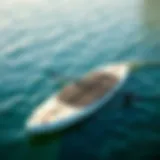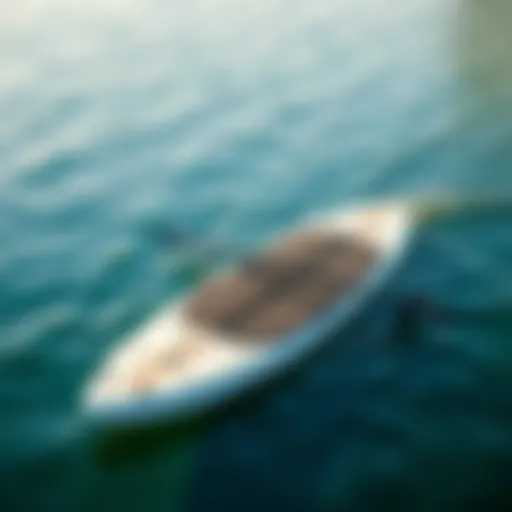Kitefoiling: An In-Depth Exploration of the Sport
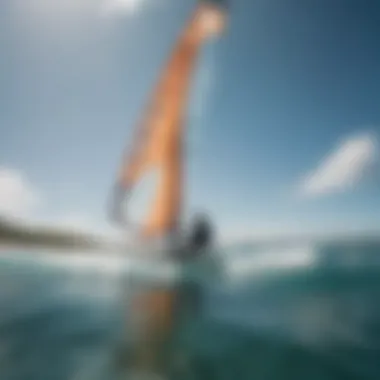

Intro
Kitefoiling has become a thrilling sport that combines multiple elements from surfing, kiteboarding, and advanced hydrofoil technology. It's not merely about riding the waves but also about suspending above them, riding the wind while harnessing the power of the ocean. As this discipline grows in popularity, understanding its fundamentals becomes essential for both newcomers wanting to join the fun and experienced practitioners looking to refine their skills.
In this guide, we're going to take an in-depth look at kitefoiling, covering essential techniques, equipment needs, safety measures, and the environmental considerations surrounding the sport. This composite experience intertwines adrenaline, zen, and a respect for the marine ecosystem, painting a holistic picture of what kitefoiling brings to the table.
Surfing Techniques
The craft of kitefoiling is not just about the equipment; it's deeply influenced by the techniques employed by the riders. Those who have mastered basics can take their skills to new heights—literally.
Beginner Tips for Getting Started
For those just dipping their toes into the water, mastering fundamental techniques is crucial. Begin by focusing on balance and control.
- Work on your stance: Stand with feet shoulder-width apart, knees slightly bent, and your weight centered over the board. This position helps in maintaining stability.
- Start on flat water: Finding a calm and flat area allows you to focus on kite control and body positioning without the added challenge of waves.
- Practice launching and landing your kite: Ensuring you can launch and land safely will boost your confidence significantly.
- Learn to steer: Use the bar to control the kite's movements, focusing on keeping it steady in the wind. Moving the kite in a smooth, figure-eight pattern can help you learn control.
Advanced Maneuvers and Tricks
Once the basics are mastered, you can look towards executing advanced maneuvers. These moves can not only improve your skills but also elevate your experience on the water.
- Transitions: These involve shifting from one direction to another without losing speed. This requires timing and precision.
- Jumping: Achieving height is all about timing the wind and the wave. Pulling the bar in while pushing down on your back foot gives lift.
- Tricks like the backroll or frontflip: Advanced riders can include spins and flips, demanding high levels of control and skill.
"Kitefoiling is as much about understanding the elements as it is about the ride itself. Mastery comes from blending techniques with an appreciation for nature's ever-changing moods."
Surfboard Selection
Choosing the right surfboard can profoundly impact your kitefoiling experience. A board that suits your riding style can offer better performance and make learning easier.
Choosing the Right Board for Your Style
Different boards are available, and selecting one that fits your style is essential. Here are key points to consider:
- Size matters: Larger boards provide more stability, especially for beginners. As you gain confidence, smaller boards can help with agility and speed.
- Board shape: Look for features like rocker and width, which will influence how the board rides the waves. Different shapes can cater to various conditions.
- Material selection: Boards can be made from foam or composite materials. Each has its advantages in weight, buoyancy, and durability.
Surfboard Maintenance and Care
Maintaining your board is just as important as choosing the right one. Proper care can extend the longevity of the equipment.
- Rinse after use: Ensure you rinse your board with fresh water after each session to remove salt and debris.
- Check for damage: Regularly inspect your board for dings or cracks, particularly after a heavy session.
- Store wisely: Keeping your board in a cool, dry place will prevent warping and fading.
In summary, kitefoiling offers a unique blend of excitement and connection with nature. Understanding its techniques, equipment, and sustainable practices enhances not only your experience but also enriches the culture surrounding the sport.
Foreword to Kitefoiling
Kitefoiling has become a captivating blend of skill, technology, and thrill on the water. It is more than just a sport; it’s a sensory experience that engages both body and mind. As a mix of surfing, kiteboarding, and hydrofoil design, this activity attracts enthusiasts who appreciate the rush of harnessing the wind while gliding above the surface of the water.
Understanding kitefoiling is vital for anyone looking to embark on this exhilarating journey. The importance of this topic is reflected in the challenge and excitement of riding a hydrofoil, as well as the community and culture that surrounds it. Kitefoiling not only enhances the performance capabilities of riders but also opens up new avenues for exploration, navigation, and connection with nature.
Benefits of learning about kitefoiling include:
- Improved technique when transitioning from traditional kiteboarding to this advanced discipline.
- Knowledge of the extensive range of equipment available, from kites to boards, enabling enthusiasts to make informed decisions.
- Awareness of safety protocols that ensure a more secure experience.
Through this section, we will illuminate the fundamental aspects of kitefoiling, setting the stage for a better grasp on its mechanics and other associated elements.
Definition and Overview
Kitefoiling is a water sport that involves riding a hydrofoil board while being propelled by a kite. This innovative approach allows surfers to rise above the water’s surface, reducing drag, and creating a unique sensation akin to flying. The hydrofoil typically consists of a long mast connected to a board at the top and a wing submerged beneath the water, which lifts the board into the air as speed increases. This phenomenon not only enhances ride quality but allows for smoother experiences even in choppy conditions.
The essence of kitefoiling lies in its simplicity; at its core, it’s about harnessing the wind's power to glide effortlessly on water. Whether you’re a seasoned water sports enthusiast or a newcomer intrigued by this adrenaline-pumping discipline, grasping the definition and the mechanics behind kitefoiling is the first step towards mastery.
Historical Context
The roots of kitefoiling stretch back to the early 1970s when surfing and sailing enthusiasts began experimenting with various hydrofoil designs. However, the sport as we know it today gained momentum in the early 2000s, thanks to innovations in kite design and advances in hydrofoil technology. Companies like Liquid Force and Slingshot introduced boards that allowed riders to combine their love for kiteboarding with the exciting dynamics of foiling.
As the sport grew in popularity, so did the diversity of techniques and styles intermixed with kitefoiling. Events and competitions began emerging around the globe, encouraging even more participation and commitment. The community surrounding kitefoiling flourished, giving rise to a culture where sharing knowledge, experiences, and innovations became the norm.
As kitefoiling continues to evolve, it prominently sits at the crossroads of tradition and modern technology. Knowing its historical context not only deepens appreciation for the sport but also informs current practices and expectations. Understanding the milestones that shaped kitefoiling fosters insight into the skills and techniques demanded in today’s exhilarating waters.
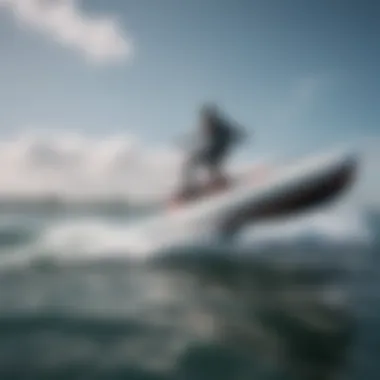

Understanding the Mechanics
The mechanics behind kitefoiling are critical to comprehending how this dynamic sport operates. In essence, kitefoiling combines the power of a kite with the lift generated by a hydrofoil, allowing riders to traverse water surfaces with remarkable efficiency. This section dives into the nuances of hydraulic lift, aerodynamics, and the detailed interaction between the kite and the water.
Understanding these mechanics not only enhances the experience for novices and seasoned kitefoilers alike, but it also empowers riders to refine their skills, optimizing performance and safety on the water.
Hydrofoils Explained
Hydrofoils are the veritable backbone of kitefoiling. These structures, resembling elongated wings, are submerged underwater and lift the rider above the water's surface as speed increases. This elevation significantly reduces drag, leading to smoother rides and the ability to glide effortlessly atop waves.
- Types of Hydrofoils:
- Freeride Foils: Designed for easy handling and versatility, ideal for beginners.
- Race Foils: Engineered for speed and performance, suited for competitive environments.
- Surf Foils: Built for dynamic maneuvering in waves, allowing for intense surfing experiences.
The choice of hydrofoil not only affects performance but also the rider's experience. For instance, a heavier rider might opt for a larger front wing to gain more lift at lower speeds, especially when learning. Conversely, advanced riders might select a smaller wing to achieve higher speeds and tighter turns.
"The beauty of hydrofoils lies in their ability to transform a simple kite and board into a vehicle of thrilling capabilities, enabling riders to skim above water surfaces at incredible speeds with the right setup."
Crucially, understanding how hydrofoils function involves a grasp of lift, drag, and foil angle. The angle at which the hydrofoil meets the water’s surface (usually around 5-10 degrees) is crucial. Too steep, and you'll generate excessive drag; too shallow, and you won't generate enough lift. Fine-tuning this angle according to skill level and conditions is part of developing one’s kitefoiling expertise.
Kite Dynamics
Kite dynamics play a vital role in how effectively a rider harnesses wind power and converts it into motion. Each kite can behave differently based on its shape, size, and design. For instance, a larger kite captures more wind but can be harder to control, particularly in gusty conditions.
Here’s what one needs to consider:
- Kite Shape:
- C-shaped Kites: Provide great lift and power, suitable for competitive kitefoiling.
- Delta Kites: Known for stability and user-friendliness, ideal for beginners.
Understanding steering techniques is also pivotal. The position of the kite in the wind window dictates the amount of lift generated. Riders need to master subtle movements – pulling on one handle may send the kite upwards, while the opposite pulls it downward, dramatically altering speed and height.
Practicing these dynamics involves a combination of intuition, experience, and environmental awareness. Recognizing wind patterns, how to adjust kite control during practice, and learning to discern how those elements affect the ride can be a game-changer even for seasoned riders.
By effectively integrating the knowledge of hydrofoils and kite dynamics, kitefoilers can make informed, tactical decisions during their rides. Ultimately, understanding these mechanics not only elevates one’s safety on the water but enriches the entire kitefoiling experience.
Essential Equipment for Kitefoiling
Kitefoiling isn't just about zipping across waves with a kite in tow; it's about having the right gear that makes the experience both safe and thrilling. The importance of equipmnet in this pursuit can't be overstated, as the right tools not only enhance performance but ensure a rider’s safety out on the water. In kitefoiling, three main components make a world of difference - kite types, foil boards, and safety gear. Let’s delve into each of these essential elements.
Kite Types
When it comes to kitefoiling, selecting the appropriate type of kite is crucial. Kites come in various shapes and sizes, tailored for different wind conditions and rider abilities.
- Leisurely Kites: These are ideal for beginners, offering a stable ride that makes it easier to manage for those just starting out.
- Performance Kites: Designed for seasoned riders, they react faster and have a better lift, making them perfect for tricks and jumps.
- Foiling Specific Kites: These are specifically engineered to work well with hydrofoils. They're shape designed to provide optimum lift with minimum drag which is a must for smooth gliding at high speeds.
The right kite for your riding style can make the difference between a delightful experience and a frustrating one. Understanding your own abilities and the conditions you'll face plays a vital role in your selection. An experienced kitefoiler knows that the wind’s direction and strength can dictate the kite choice; those subtleties aren't just technical, they're part of the art of kitefoiling.
Foil Boards
Next up, we have foil boards, another pivotal piece of equipment. They are unlike regular boards; their hydrofoil lifts the board above the water's surface as it gains speed.
- Size and Shape: The dimensions of the board are key to your experience. Larger boards offer higher stability for novices, but as one's skill set grows, a smaller and more agile board can enhance performance.
- Material Composition: Boards vary from lightweight to robust options, affecting how they handle waves and wind. Materials like carbon fiber are fantastic for lightweight and responsive boards, while fiberglass options are often more durable.
- Fin Setup: The fin configuration has a direct influence on how a board will perform during turns and speed adjustments, impacting the overall control you have during the ride.
Choosing the right foil board falls in line with understanding what you want to achieve in your kitefoiling journey—be it smooth cruising or aerial feats.
Safety Gear
No discussion of kitefoiling is complete without touching on safety gear. In a sport that blends speed with unpredictable elements, being safe is paramount.
- Helmets: A good helmet protects the head during sudden falls or collisions. Lightweight designs are preferable to make sure it doesn't hinder movement.
- Impact Vests: These garments not only protect the chest and back but also provide buoyancy. They can be crucial in emergencies when one may find themselves in tricky situations.
- Leashes: A leash connects you to your kite, so if you find yourself falling or losing control, the kite can’t drift off into the distance.
"Kitefoiling is like a dance with the wind; timing and connection to your equipment is the key to success.”
The extent to which you want to engage with kitefoiling directly informs what gear will best suit your needs. Investing in quality equipment sets the foundation for both safety and fun.
In summary, kitefoiling necessitates a thoughtful approach to equipment selection. Consider the kite types to suit your skill level, select a foil board that enhances your experience, and prioritize your safety gear. Mastering these elements not only elevates your performance but ensures that the thrill of kitefoiling remains an exhilarating yet safe endeavor.
Learning Kitefoiling
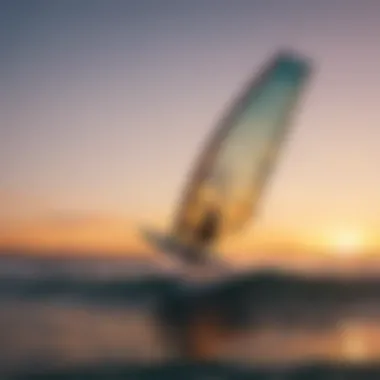

Learning kitefoiling is an essential phase for anyone looking to navigate those winds and waters successfully. This segment is not merely about acquiring a new skill; it's about understanding the blend of techniques, safety, and adaptability that makes this sport unique. For both beginners and seasoned practitioners, diving into kitefoiling means discovering the kinesthetic joy of riding above the water, coupled with the power of wind. It can feel like sailing in thin air, especially at those moments where you glide effortlessly on the hydrofoil.
Beginner Techniques
Getting started in kitefoiling can seem daunting, but it doesn’t have to be. The reward is worth the initial struggle. First off, understanding your kite is paramount. Beginners should begin practicing with small, lightweight kites, as they are easier to control. Learning how to harness the wind with your kite is like getting to know a dancing partner — it's all about rhythm and timing.
Here are some foundational techniques to master:
- Kite Control: Start with basic flying techniques on the beach. This helps in grasping how your inputs affect the kite.
- Body Positioning: When you’re on the board, maintaining an upright stance with your knees slightly bent is crucial. It provides balance as you find your rhythm.
- Edge Control: Learning to edge the board effectively helps you maintain speed and stability. This means shifting your weight — lean forward to generate speed, and back to slow down.
- Water Starts: Practice the water start technique step by step. Begin kneeling on the board with your kite at around 45 degrees to the wind and gradually stand up as you pull with the kite.
With these techniques under your belt, you’re set to ride the waves and experience that exhilarating sensation of foiling as you lift above the surface.
Advanced Maneuvers
Once you’ve gained confidence, the world of advanced maneuvers beckons like an open invitation. This is where the true artistry of kitefoiling reveals itself. Advanced maneuvering demands a combination of skill, intuition, and practice. After all, it's not just about getting airborne; it’s about how you make it an artistic expression.
Consider these techniques to elevate your kitefoiling game:
- Carving Turns: Focus on making smoother and sharper turns. Lean into the direction you wish to go while maintaining kite control.
- Jumping: Developing proficiency in jumps involves using the speed you generate and a little lift from your kite. Timing your pull and releasing at the peak will have you soaring.
- Wave Riding: Once you’re comfortable, delving into wave riding not only offers a thrill but also connects you more closely to the marine environment. It's a dance with nature, riding the crest of each wave.
- Tricks and Stunts: After mastering jumps, you can challenge yourself with tricks like rotations or backflips. Here you blend style with technique, but remember — practice makes perfect!
In the world of kitefoiling, continuous learning is part and parcel of the adventure. The journey begins with those fundamental techniques, and as you gather experience, you’ll find the water becomes less of an obstacle and more of a playground.
"The beauty of kitefoiling lies not just in the thrill, but in the joy of mastery — every session teaches you something new."
Embrace the process, respect the elements, and above all, enjoy the ride.
Safety Protocols in Kitefoiling
When it comes to kitefoiling, ensuring safety is paramount. Kitefoiling takes place in unpredictable environments that can change in the blink of an eye. Wind conditions, water movements, and the presence of other riders can all affect safety. Ignoring safety protocols not only jeopardizes the individual rider but can also impact others in the vicinity. Hence, understanding and adhering to safety protocols can make the difference between an exhilarating session and a harrowing experience.
Pre-Ride Safety Checks
Before hitting the water, it’s vital to perform a series of pre-ride safety checks. These checks not only prepare your equipment but also ensure you’re in the best possible shape to face the elements. Here’s a quick rundown:
- Inspect your Kite: Check for any damages on the fabric or lines. Any small tear or fray can become a bigger problem out on the water.
- Harness and Safety Release: Make sure your harness is secure and the quick-release system functions correctly. This can be the life-saving mechanism you need if anything goes wrong.
- Check the Foil Board: Ensure there are no loose screws or cracks. A malfunctioning board can be hazardous.
- Wind Conditions: Assess if the wind conditions are suitable for your skill level. If the wind is too gusty or too light, it’s prudent to rethink your session.
- Safety Gear: Ensure you are equipped with a helmet and impact vest or life jacket. This gear is essential for protection, especially when learning new tricks or navigating tricky waters.
By systematically going through these checks, riders not only secure their own safety but also contribute to a safer environment for fellow kitefoilers.
"Safety is not just a protocol; it’s a mindset for every kitefoiler."
Understanding and Evaluating Conditions
Evaluating weather and water conditions is crucial before stepping into the surf. It goes beyond simply glancing at the waves or feeling the breeze. Here’s how kitefoil riders can better gauge the setup:
- Wind Speed and Direction: Use apps or websites that provide real-time wind data. Understanding how the wind flows over the water can affect your ride significantly. Offshore winds can be a recipe for disaster; you might end up drifting away from the shore.
- Tides and Currents: Tidal shifts can change the landscape of a familiar riding area. A sudden shift in tide can lead to unforeseen challenges, such as stronger currents or rocks becoming exposed. Know the tide times and how they influence your intended spot.
- Wave Size and Movement: Assessing waves is essential, especially for those attempting tricks. Large, messy waves or choppy waters can be challenging, while smaller, clean waves may provide an ideal playground.
- Local Hazards: It’s also wise to familiarize yourself with local hazards such as sandbars, shallow areas, and obstructions like rocks or piers. Understanding the area can prevent accidents.
In summary, being prepared and knowing the environment can greatly reduce risks. A thoughtful and practiced approach to both pre-ride checks and understanding conditions will pave the way for safe and exhilarating kitefoiling experiences.
Environmental Considerations
The interaction between kitefoiling and our oceans highlights a critical part of this sport that often goes unnoticed. Understanding the environmental implications can shape how practitioners approach their passion while preserving the beauty of our waters. With kitefoiling gaining popularity, it becomes essential to embrace responsible practices. Awareness in this area helps ensure that the thrill of riding waves doesn’t come at the cost of marine life.
Impact on Marine Life
The delicate balance in marine ecosystems can easily be disrupted by human activities. Kitefoiling, while exhilarating, has the potential to affect underwater habitats if practitioners aren't mindful.
- Noise Pollution: The sound from kitefoiling equipment can disturb aquatic animals. Many marine species rely on sound for communication, feeding, and navigation, and excessive noise may lead to stress or disorientation.
- Physical Interactions: Collisions with marine wildlife, such as fish or sea turtles, although infrequent, can happen. Kitefoilers must always keep an eye on their surroundings to avoid harming these creatures.
- Environmental Habitats: Anchoring and setting up gear near sensitive habitats can lead to degradation. Sea grass beds and coral reefs are particularly vulnerable. It’s recommended not to launch or land near these crucial ecosystems.
It's vital for kitefoilers to be stewards of the environment, not just thrill-seekers. Simple actions like respecting wildlife zones and adhering to local regulations can significantly lessen the impact on marine life.
"We do not inherit the earth from our ancestors; we borrow it from our children."
— Native American Proverb
Sustainable Practices
Adopting sustainable practices is not only beneficial for the environment but can also enhance the kitefoiling experience. Here are a few ways to practice sustainability while enjoying this sport:
- Choose Eco-Friendly Gear: Equip yourself with products created from sustainable materials. Many brands now offer eco-conscious options.
- Plan Your Locations: Be mindful of where you kitefoil. Opt for areas known for minimal environmental impact and avoid those close to sensitive wildlife habitats.
- Participate in Clean-ups: Many kitefoiling communities organize meets that include beach or ocean clean-ups. Joining these initiatives contributes directly to protecting marine environments.
- Educate Yourself and Others: The more you know about the local marine ecosystem, the higher the chance your practices won’t be harmful. Share your knowledge with fellow kitefoilers to foster a culture of sustainability.
- Follow Guidelines: Each location often has specific guidelines regarding kitefoiling. These rules are in place to protect wildlife and habitats; respecting them reflects responsible riding.
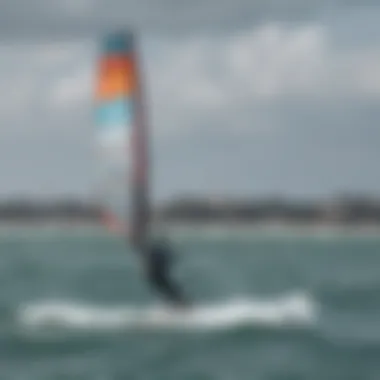

By weaving sustainability into the fabric of kitefoiling, enthusiasts can enjoy their passion while being proactive in safeguarding our ecological treasures. This doesn’t just preserve the thrill of kitefoiling for today’s generation but ensures that future indulgers can experience the pure joy of harnessing the wind on water.
Popular Kitefoiling Destinations
Exploring the world of kitefoiling is not just about mastering the techniques or investing in top-notch equipment; it’s also about where you choose to launch your adventures. The locations you pick can significantly influence your experience, offering varying wind conditions, breathtaking views, and a friendly community of fellow enthusiasts. Kitefoiling spots can make or break your experience and understanding the appeal of certain places can enhance both your enjoyment and skill development.
North America Hotspots
In North America, kitefoiling is thriving, particularly in places that offer consistent winds and expansive water areas. One major hotspot is Cape Hatteras in North Carolina. Known for its reliable wind patterns and picturesque scenery, it serves as a haven for both beginners and seasoned riders. The shallow waters allow newcomers to practice without the fear of deep-water mishaps.
- The Outer Banks boasts a vibrant kiteboarding community, making it an ideal training ground.
- San Francisco Bay Area is another locale drawing attention, with its powerful winds and scenic views of the Golden Gate Bridge. Here, both amateurs and pros push their limits in iconic settings.
- Lake Michigan, specifically locations like Holland or Windsurfing Point, also provide a unique kitefoiling experience, especially during late summer months with steady breezes.
These areas offer a blend of fun and challenge, hosting numerous competitions and social gatherings that can further enhance your kitefoiling journey.
European Locations
Europe presents its own array of kitefoiling gems that lure surfers from all over the globe. Tarifa in Spain, often dubbed the kiteboarding capital of the world, offers near-perfect conditions year-round. The strong winds from the Levante and Poniente make it a prime destination.
- Lago di Garda in Italy delivers stunning backdrops alongside favorable wind conditions, making it another must-visit spot for kitefoilers.
- The south coast of France, particularly around La Franqui, is another hotspot with its melange of warm weather and reliable wind. This area also hosts major competitions that can provide both spectacle and inspiration.
The diverse landscapes and established communities in these regions enhance the kitefoiling experience while also offering opportunities to connect with fellow adventurers.
Exotic Spots
For those looking to venture beyond familiar shores, exotic kitefoiling spots can provide both adventure and tranquility. Places like Maui in Hawaii have become legendary among watersport enthusiasts. The combination of warm waters, steady winds, and captivating scenery is simply unmatched.
- Kite Beach is properly named and offers a vibrant atmosphere with a rich community spirit.
- Bora Bora in French Polynesia stands out with its picturesque lagoons and gentle breezes, making it a dream destination for kitefoilers seeking a blend of relaxation and sport.
The allure of kitefoiling in beautiful, far-flung destinations lies not only in the thrill of the sport but also in the cultural and recreational experiences waiting in these remarkable places.
"Each location offers a unique twist on the kitefoiling experience—whether it’s the winds, the waves, or the people you meet along the journey."
The Kitefoiling Community
The kitefoiling community, like the waves on a breezy day, is vibrant, dynamic, and full of life. It's more than just a gathering of enthusiasts; it represents a collective spirit united by a passion for the sport and its thrilling encounters on the water. This community plays a significant role in fostering a sense of belonging among kitefoilers, whether they be seasoned veterans or eager newcomers. Connecting with others who share similar interests and experiences can provide invaluable support and knowledge as one navigates this exhilarating sport.
Clubs and Organizations
Within this community, clubs and organizations serve as the backbone, providing structure and opportunities for kitefoilers to engage with one another. The camaraderie often springs from local clubs that organize meet-ups, lessons, and group outings. These organizations create an engaging environment conducive to learning and sharing techniques, tips, and tricks. For instance, clubs like the International Kiteboarding Association (IKA) not only promote kiteboarding and its various facets, including kitefoiling, but they also hold competitions that showcase up-and-coming talent on the global stage.
Furthermore, local kitefoiling clubs regularly host events that help members improve their skills while fostering community bonds. These gatherings provide an excellent platform for novices to interact with experienced kitefoilers, gaining valuable insights that go beyond what one might pick up from a YouTube video or even a seasoned instructor. Here are some key benefits of joining a club:
- Learning Opportunities: Access to clinics and workshops to enhance skills.
- Safety in Numbers: Being part of a group ensures a safer kitefoiling experience, especially in unfamiliar locations.
- Equipment Sharing: Many clubs have communal gear that newbies can try before making an investment.
- Traveling Together: Clubs often organize trips to prime kitefoiling locations, making logistical arrangements easier.
Events and Competitions
Events and competitions are the lifeblood of the kitefoiling community, igniting the competitive spirit in many. These gatherings not only highlight the exhilarating aspects of it but also encourage participants to push their limits. From local regattas to international championships such as the Kitefoil World Series, these events are thrilling to watch and participate in. They often bring together talented athletes from around the world, providing a showcase for spectacular maneuvers and innovative techniques.
The atmosphere at these competitions is electric, offering opportunities for kitefoilers to witness maneuvers they aspire to learn. Importantly, they also underscore a spirit of sportsmanship and mutual respect among competitors. Events frequently feature both performance-based categories and freestyle competitions, appealing to a wide array of interests within the sport. There’s a real buzz that occurs when competitors come together, pushing each other to greater heights while sharing their passion for kitefoiling.
Moreover, many events cater to both advanced and beginner levels, ensuring inclusivity. These competitions often have categories tailored for emerging kitefoilers, amplifying excitement and encouraging newcomers to step out of their comfort zones.
In summary, the kitefoiling community embodies the essence of this sport. Clubs and organizations cultivate connections, foster learning, and promote safety, while events and competitions amplify excitement and excellence. This intricate web of support enriches the overall experience of kitefoiling, making it not just a sport, but a lifestyle woven into the fabric of shared adventures and aspirations.
"The community around kitefoiling is like the wind—sometimes strong, sometimes gentle, but always essential for taking flight."
For more information on forms of community organization in the sport, you can visit Wikipedia, or join dedicated discussions on Reddit for insights from fellow kitefoilers.
Closure
The significance of this conclusion rests not just in wrapping up our comprehensive study of kitefoiling, but in heralding the sport's bright future. In an era where adventure sports are gaining traction, kitefoiling combines a unique synergy of thrill, skill, and innovation. Those who engage in kitefoiling often express a profound sense of freedom gliding above the water, a phenomenon that is hard to replicate in other sports.
A primary consideration for the ongoing growth of kitefoiling is the technology behind it. Advances in materials and designs serve to enhance performance and safety, which is vital for attracting newcomers. Brands like Naish and Slingshot have consistently upped the ante in gear innovation, making kitefoiling more accessible to a wider audience.
Reflecting on the community aspect, kitefoiling thrives on shared knowledge and camaraderie among enthusiasts. Clubs and organizations play a pivotal role in fostering connections among riders; whether you are in the local beach scene or at an international event, the bonds formed through shared experiences are invaluable. This collective spirit not only enriches the sport but also aids in preserving its values and ethics.
Future of Kitefoiling
Looking forward, several factors will shape the landscape of kitefoiling in the coming years.
- Technological advancements: Innovations in hydrofoil design will likely yield greater control, efficiency, and ease of use. Companies are experimenting with different materials and shapes to maximize performance.
- Increased participation: Kitefoiling is seeing varied demographics join the fray, from young athletes to older adventurers, breaking down generational barriers.
- Environmental consciousness: As awareness of ecological impact grows, there will be a push for more sustainable practices within the kitefoiling community. This will include everything from eco-friendly gear choices to responsible riding practices that help protect marine ecosystems.
- Global reach: New kitefoiling hotspots are emerging worldwide, allowing enthusiasts to enjoy stunning locations while sharing knowledge and techniques.
The kitefoiling community has a genuine chance to redefine adventure sports, placing emphasis on sustainability and community while conquering both sea and sky.
In short, the future of kitefoiling is not just about riding waves or catching winds; it is about embracing a culture that blends passion, responsibility, and innovation. From coastlines to competitions, kitefoiling is poised to leave a lasting imprint on the sports landscape.


